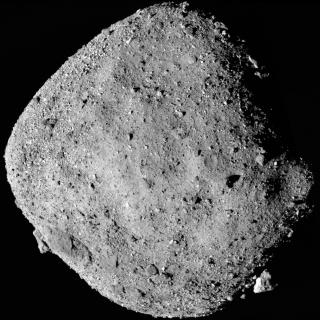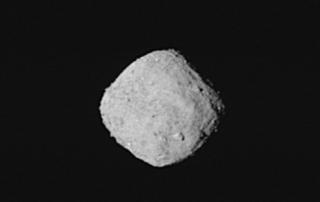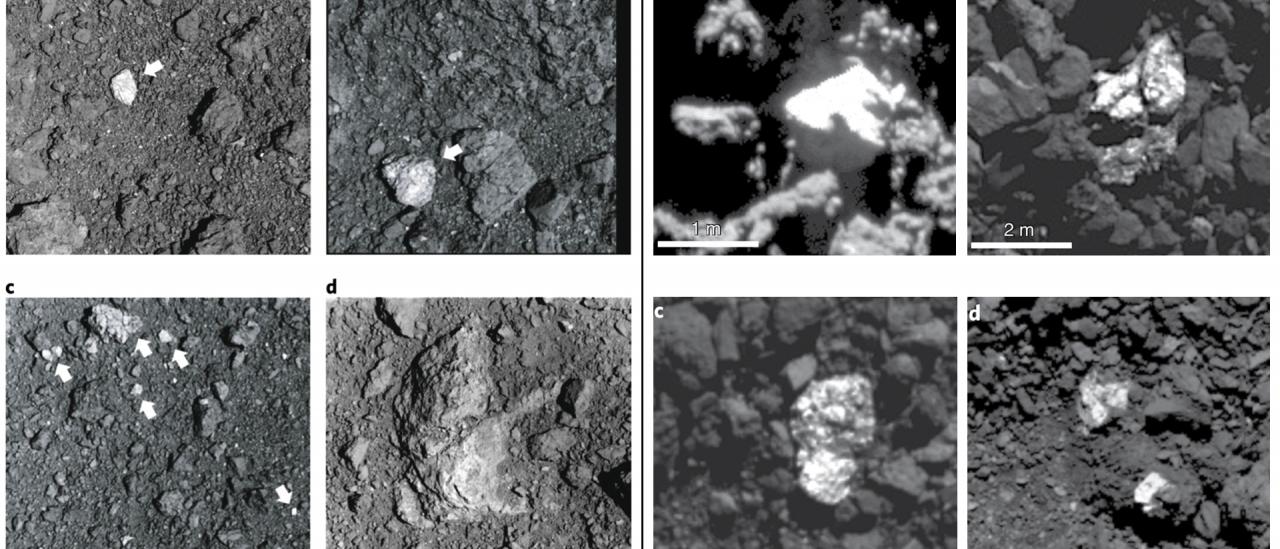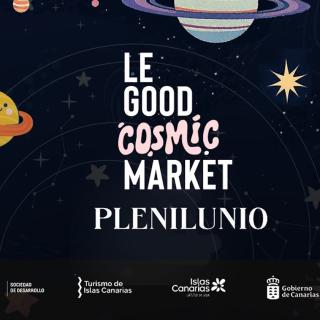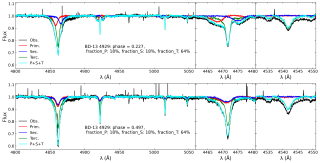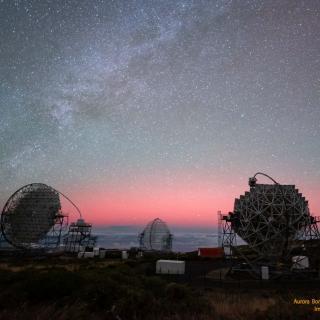The two near-Earth asteroids Ryugu and Bennu, primary targets of the Hayabusa2 (JAXA) and OSIRIS-REx (NASA) space missions, keep surprising us. In two companion papers presented in Nature Astronomy, researchers have found exogenous bright material scattered across the asteroids’ surfaces. Members of the Solar System Group of the Instituto de Astrofísica de Canarias (IAC) have contributed to this discovery, in particular Dr. Eri Tatsumi, who is the first author of the paper presenting findings on Ryugu (Hayabusa2).
Ryugu and Bennu are dark carbonaceous asteroids with their albedo being no higher that 4-5%. They are both targeted to sample their surface materials by JAXA’s Hayabusa2 and NASA’s OSIRIS-REx missions. As obtaining the high-resolution images to prepare for the collecting of material, both spacecraft found extraordinary bright boulders on their surface, in contrast with the dark surroundings. Those bright boulders were analyzed by each team and results were presented as two companion papers in Nature Astronomy. Julia de León, Juan Luis Rizos Garcia, Javier Licandro, and Eri Tatsumi, researchers at the Instituto de Astrofísica de Canarias (IAC) and members of the OSIRIS-REx Image Processing Working Group (IPWG), are among the authors of the papers. It is worth noting that Eri Tatsumi is the first author of the paper on Ryugu’s bright boulders and is also a member of Hayabusa2 ONC (Optical Navigation Camera) team.
“Hayabusa2 team found many bright boulders on Ryugu as the proximity operations were being conducted by ONC images” explains Eri Tatsumi. “We analyzed the visible color of 21 bright boulders, larger than a few 10 cm using multi-band images, and classified them into two spectral groups: carbonaceous-type and stony-type. Six stony-type boulders appeared to be distinctively bright and have similar spectra to those of ordinary chondrites, confirmed by data obtained by the spectrometer NIRS3, also on-board the spacecraft”. Ordinary chondrite meteorites are composed mainly of bright, anhydrous silicates like olivine and pyroxene. “There is a large asteroid family in the inner main asteroid belt, the Nysa-Polana-Eulalia complex, which is a mix of carbonaceous (or primitive) stony asteroids. Ryugu is believed to originate in the carbonaceous Polana family. Thus, it is probable to have impacts between carbonaceous and stony asteroids, that could explain the presence of the bright material on the surface of Ryugu”, remarks Eri Tatsumi.
Similarly, the unusual boulders on Bennu first caught the team’s eye in images from the OSIRIS-REx Camera Suite (OCAMS). They found six extremely bright boulders ranging in size from 1.5 to 4.3 m. They analyzed the light from the boulders using the OSIRIS-REx Visible and Infrared Spectrometer (OVIRS) instrument to get clues to their composition. The signature from the boulders was characteristic of the mineral pyroxene, similar to what is seen on Vesta and the vestoids, smaller asteroids that are fragments blasted from Vesta when it sustained significant asteroid impacts.
These are the first results on exogeneous materials found on asteroids like Ryugu or Bennu, considered rubble-pile asteroids. “Rubble-pile asteroids are thought to be resulted from catastrophic disruptions of much larger parent bodies and following re-accumulation by gravitational force” explains Julia de León. This implies that the materials of the parent body and the projectile asteroid could be mixed during the process to create rubble-pile asteroids. OSIRIS-REx team found exogenic basalts on Bennu while Hayabusa2 team found ordinary-chondrite-like materials on Ryugu. “These two materials are unlikely to form in the same asteroid, suggesting different parent bodies and impact histories for Ryugu and Bennu, although both asteroids were indicated to be delivered from the inner main asteroid belt based on their orbits”, says Eri Tatsumi.
Hayabusa2 conducted two successful touchdowns on 21 February and 11 July 2019 to collect material from the surface of Ryugu, and is now coming back to the Earth with the samples in this December. OSIRIS-REx is going to make its first attempt to sample Bennu in October and return it to Earth 2023. “Those sampled materials may include the small fraction of those bright boulders and will reveal detailed histories on these two amazing asteroids”, sentences Tatsumi.
Papers:
- Tatsumi et al. “Collisional history of Ryugu’s parent body from bright surface boulders”, Nature Astronomy, 2020, DOI: 10.1038/s41550-020-1179-z
- DellaGiustina et al. “Exogenic basalt on asteroid (101955) Bennu”, Nature Astronomy, 2020. DOI: 10.1038/s41550-020-1195-z
NASA press release:
NASA’s OSIRIS-REx to Asteroid Bennu: “You’ve got a little Vesta on you…”
Contact at the IAC:
- Eri Tatsumi: etatsumi [at] iac.es (etatsumi[at]iac[dot]es)
- Julia de Léon: jmlc [at] iac.es (jmlc[at]iac[dot]es)


